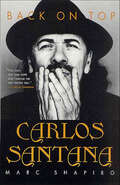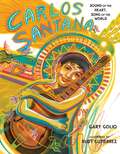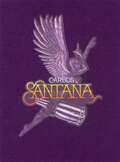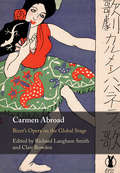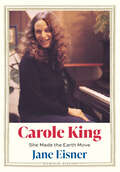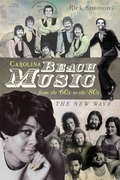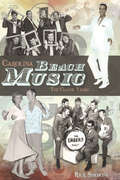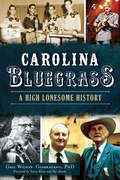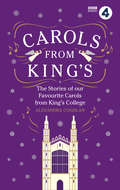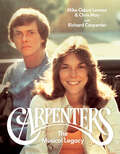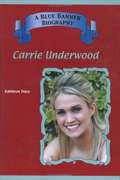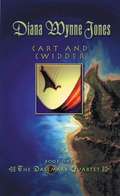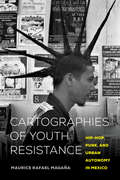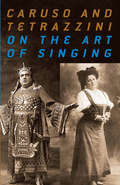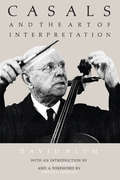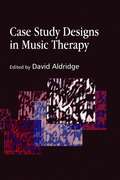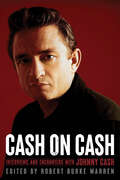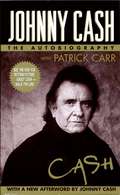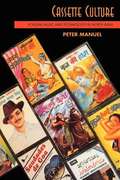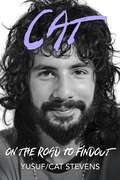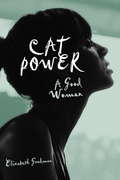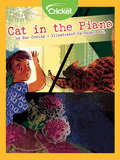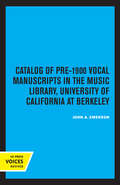- Table View
- List View
Carlos Santana: Back on Top
by Marc ShapiroCarlos Santana took the music world by storm back in 1969 with his thrilling performance at the Woodstock festival. He was the first guitarist to skillfully blend fiery rock riffs with Latin, blues and sensuous Afro-Cuban rhythms to create a unique and unforgettable sound. His vision to create innovative melodies has earned him a magnitude of critical praise and acclaim over his illustrious career. But, the road to success has been a rocky, uphill climb.The middle child of seven children, Carlos Santana was born on July 20, 1947 in a tiny Mexican village where the homes were comprised of brick and mud, and there was no running water or lights. But, what his parents couldn't give in material wealth, they heaped upon their children in love. It was after the family moved to Tijuana that twelve year old Carlos developed his talent for the guitar and his reputation as a formidable musician spread. In 1968 Columbia Records signed on the Santana Blues Band and they began in earnest to work on an album that would include such popular Latin and soul favorites as "Black Magic Woman," "Evil Ways," and "Oye Como Va". On August 15, 1969, the Santana band was given the opportunity to play Woodstock before the release of their first album and this performance would forever be etched in fans' minds as a key moment in rock history. The Santana Blues Bands went from obscurity to instant recognition. Shortly thereafter, rumblings of discontent were echoed within the group with the volatile mixture of drug abuse, personality clashes, and the frustrations over the musical direction the band, ultimately leading to the demise of the group.Following the breakup, Carlos Santana delved deeper into the meditative arts and spirituality. The succession of albums that followed were greeted with critical acclaim, but moderate success. In the late 90's, Santana begin working on a new album under the creative direction of Clive Davis, head of Arista Records. In a brilliant union of collaborating with younger artists as Lauryn Hill, Wyclef Jean, and Rob Thomas, the album, Supernatural was a commercial smash. It sold over thirteen million copies, and appealed to both the baby boomers and the teenage crowd. Carlos Santana became the star of the 2000 Grammys, and Supernatural won several awards including, Best Rock Album of the Year, Song of the Year for "Smooth", and Album of the Year. With a career that spans three decades, Carlos Santana p0has proven that talent, determination, and passion are the keys to longevity in a business that is obsessed with youth and beauty. Against the odds, he has defied the rule of convention and made an incredible comeback. His story is timeless, inspirational, and he has undoubtedly proven himself to be the king of the guitar.
Carlos Santana: Sound of the Heart, Song of the World
by Gary GolioDiscover the childhood story of Carlos Santana in Gary Golio's Sound of the Heart, Song of the World, featuring illustrations by Rudy Gutierrez, the internationally celebrated artist who created the iconic Carlos Santana Shaman CD cover.Carlos Santana grew up surrounded by music. His father, a beloved mariachi performer, teaches his son how to play the violin when he is only six years old. But when Carlos discovers American blues, he is captivated by the raw honesty of the music. Unable to think of anything else, he loses all interest in the violin. When Carlos finally receives his first guitar, his whole life begins to change.From his early exposure to mariachi to his successful fusing of rock, blues, jazz, and Latin influences, here is the childhood story of a legendary musician. Christy Ottaviano Books
Carlos Santana: The Illustrated Story of Santana’s Musical Journey
by Jeff TamarkinA Simon & Schuster eBook. Simon & Schuster has a great book for every reader.
Carmen Abroad: Bizet's Opera on the Global Stage
by Clair Rowden Richard Langham SmithFrom the 'old world' to the 'new' and back again, this transnational history of the performance and reception of Bizet's Carmen – whose subject has become a modern myth and its heroine a symbol – provides new understanding of the opera's enduring yet ever-evolving and resituated presence and popularity. This book examines three stages of cultural transfer: the opera's establishment in the repertoire; its performance, translation, adaptation and appropriation in Europe, the Americas and Australia; its cultural 'work' in Soviet Russia, in Japan in the era of Westernisation, in southern, regionalist France and in Carmen's 'homeland', Spain. As the volume reveals the ways in which Bizet's opera swiftly travelled the globe from its Parisian premiere, readers will understand how the story, the music, the staging and the singers appealed to audiences in diverse geographical, artistic and political contexts.
Carole King: She Made the Earth Move (Jewish Lives)
by Jane EisnerJane Eisner traces the professional accomplishments and personal challenges of pop icon Carole King, exploring her unique contribution to American music“An eagle-eyed telling of how King (born Carol Joan Klein) emerged from the Midwood neighborhood of Brooklyn to achieve decades of songwriting success.†?—Karen Iris Tucker, Washington Post Carole King’s extraordinary career has defined American popular music for more than half a century. Born in New York City in 1942, she shaped the soundtrack of 1960s teen culture with such songs as “Will You Love Me Tomorrow,†? one of many Brill Building classics she wrote with her first husband, Gerry Goffin. She was a leading figure in the singer-songwriter movement of the 1970s, with dozens of Billboard Hot 100 hits and music awards—her 1971 album Tapestry won a record four Grammys. Yet she struggled to reconcile her fame with her roles as a wife and mother and retreated to the backwoods of Idaho, only to emerge in recent years as a political activist and the subject of the Tony-winning Broadway show Beautiful: The Carole King Musical. Journalist and author Jane Eisner places King’s life in historical and cultural context, revealing details of her humble beginnings in Jewish Brooklyn, the roots of her musical genius, her four marriages, and her anguish about public life. Drawing on numerous interviews as well as historical and contemporary sources, this book brings to life King’s professional accomplishments, her personal challenges, and her lasting contributions to the great American songbook.
Carolina Beach Music Compilation Albums: The Classics
by Dr Rick SimmonsThe Stories Behind the AlbumsCarolina beach music—those often-soulful songs about the beach, parties, that special love, dancing or just relaxing in the sun—has long been a mainstay of culture in the Southeast. Yet until the late 1960s, you needed an impressive collection of 45s if you wanted to hear those songs in your home or at a party. But beginning with Atlantic Records’ Beach Beat in 1967, that music slowly became available on albums from Bell, Warner Bros., Ripete and other labels. Through interviews and firsthand accounts, author Rick Simmons examines the stories behind those classic albums, the people who created them and the artists and songs that contributed to the phenomenon known as Carolina beach music.
Carolina Beach Music from the '60s to the '80s: The New Wave (Music Ser.)
by Rick SimmonsThis follow-up to Carolina Beach Music: The Classic Years looks at performers including the Drifters, the Spinners, Tower of Power, Wild Cherry, and more.Carolina Beach Music from the ’60s to the ’80s: The New Wave covers more of those classic beach music tunes as well as the increasingly self-aware songs that marked the beginning of a new wave of beach music in the late 1970s and early 1980s. This book looks at eighty recordings from the years 1966 through 1982, featuring interviews and insights from the artists who sang them, including Archie Bell, William Bell, Jerry Butler, Clyde Brown of the Drifters, Harry Elston of the Friends of Distinction, Bobbie Smith of the Spinners, Emilio Castillo of Tower of Power, Rob Parissi of Wild Cherry, Billy Scott and many, many others.Includes photos
Carolina Beach Music: The Classic Years
by Rick SimmonsJust as the dances of Beach Music have their twists and turns, so too do the stories behind the hits made popular in shag haunts from Atlantic Beach to Ocean Drive and the Myrtle Beach Pavilion. In Carolina Beach Music, local author and Beach Music enthusiast Rick Simmons draws on first-hand accounts from the legendary performers and people behind the music. Simmons reveals the true meaning behind "Oogum Boogum," uncovers just what sparked a fistfight between Ernie K. Doe and Benny Spellman at the recording session of "Te-Ta-Te-Te-Ta-Ta," and examines hundreds of other true events that shaped the sounds of Beach Music.
Carolina Bluegrass: A High Lonesome History
by Gail Wilson-Giarratano Larry Klein Pat AhrensIn the Carolinas, bluegrass is more than music--it's a way of life. The origins of the genre date back to the earliest frontier settlements, and banjo music appeared at dances in Greenville, South Carolina, as early as 1780. The genre was essential to socialization in the textile mills of both states. Old-time music of the Blue Ridge Mountains heavily influenced the sound. Bill Monroe, considered by many to be the father of bluegrass, began his recording career in Charlotte in 1936. Many of the most popular bands, such as the Hired Hands and Briarhoppers, regularly performed live on local television stations in Columbia, Spartanburg and Charlotte. Today, bluegrass festivals fill local calendars across the region. Author Gail Wilson-Giarratano uses interviews and the historic record to tell this unique and compelling story.
Carols From King's
by Alexandra CoghlanThe exquisite sound of a lone chorister singing Once in Royal David’s City amid the candlelit chapel of King’s College, Cambridge, marks the start of the Christmas festivities for millions of people round the globe. Broadcast at 3pm on Christmas Eve, A Festival of Nine Lessons and Carols provides a precious moment of tranquillity amongst the bustle of the festive season. Take a journey through the fascinating history of carols, from the very first - sung by the angels to the shepherds at Bethlehem - to anecdotes from contemporary King's choristers. Learn how carols have evolved from pagan songs to become one of our nation's most sacred treasures. Accompanied by lyrics and music and compiled in conjunction with Radio 4 and King’s College Chapel, Carols From King’s is the official companion for fans of Christmas and carols alike.
Carpenters: The Musical Legacy
by Chris May Mike Cidoni LennoxIntroduction by Richard CarpenterThe definitive biography of one of the most enduring and endeared recording artists in history—the Carpenters—is told for the first time from the perspective of Richard Carpenter, through more than 100 hours of exclusive interviews and some 200 photographs from Richard's personal archive, many never published.After becoming multimillion-selling, Grammy-winning superstars with their 1970 breakthrough hit "(They Long to Be) Close to You," Richard and Karen Carpenter would win over millions of fans worldwide with a record-breaking string of hits including "We've Only Just Begun," "Top of the World," and "Yesterday Once More."By 1975, success was taking its toll. Years of jam-packed work schedules, including hundreds of concert engagements, proved to be just too much for the Carpenters to keep the hits coming—and, ultimately, to keep the music playing at all. However, Richard and Karen never took their adoring public, or each other, for granted.In Carpenters: The Musical Legacy, Richard Carpenter tells his story for the first time. With candor, heart, and humor, he sheds new light on the Carpenters' trials and triumphs—work that remains the gold standard for melodic pop. This beautifully illustrated definitive biography, with exclusive interviews and never-before-seen photographs, is a must-have for any Carpenters fan.
Carrie Underwood (Blue Banner Biography)
by Kathleen TracyFrom the Book Jacket: Carrie Underwood is the small town girl who has taken America by storm. But the road to success from her home town of Checotah, Oklahoma to her emergence as 2005's American Idol wasn't a smooth one. As a young girl music was her life, and Underwood dreamed of becoming a professional singer. But her early attempts to establish a career were met with disappointment and Carrie left music behind-until friends and family encouraged her to audition for American Idol. The story of how Carrie Underwood made her dreams come true while winning the hearts of fans everywhere is not only uplifting but an inspiring reminder of how you should always follow your dreams.
Cart and Cwidder
by Diana Wynne JonesCart and Cwidder is the first in the best-selling Dalemark Quartet of books and tells the story of Moril and his brother and sister who are travelling musicians journeying through Dalemark, until one day they pick up a mysterious passenger. Somehow Moril's family and the stranger are becoming bound together in terror, flight, and music.
Cartographies of Youth Resistance: Hip-Hop, Punk, and Urban Autonomy in Mexico
by Maurice Rafael MagañaIn his exciting new book, based on a decade of ethnographic fieldwork, Maurice Magaña considers how urban and migrant youth in Oaxaca embrace subcultures from hip-hop to punk and adopt creative organizing practices to create meaningful channels of participation in local social and political life. In the process, young people remake urban space and construct new identities in ways that directly challenge elite visions of their city and essentialist notions of what it means to be indigenous in the contemporary era. Cartographies of Youth Resistance is essential reading for students and scholars interested in youth politics and culture in Mexico, social movements, urban studies, and migration.
Caruso and Tetrazzini On the Art of Singing
by Luisa Tetrazzini Enrico CarusoTwo of opera's greatest names offer encouragement and useful advice to aspiring singers in this classic guide. Tenor Enrico Caruso and coloratura soprano Luisa Tetrazzini employ nontechnical terms to provide an informal vocalist's anatomy, with instructions for the proper training, care, and disposition of the tongue, lungs, diaphragm, mouth, and the voice itself.Tetrazzini deals with the foundations of singing in breath control; tone emission and attack; and, sending aspiring performers to the mirror, facial expression and dress. Caruso remarks on tone production; such faults as the "white voice" and "goat voice"; the necessity of good diction; the role of diet; and the part superstition plays in certain singers' performances. These consummate artists show great charm and presence as writers, and this little book is a great pleasure to read.
Casals and the Art of Interpretation
by David Blum"This is an immensely valuable book and one which is clearly designed to appeal to all musicians--not just string players...Mr. Blum has captured in great detail the little things that so often make a great teacher. I would strongly recommend this book to anyone with an interest in the Art of Interpretation."--Music Teacher"The volume belongs to an exceptional class of literature: it is to be welcomed as a significant contribution. In his Forward, Antony Hopkins in a most eloquent way makes us fully aware of our possible great loss had the subject material forming this book not been preserved for posterity...throughout the book one remains not only an absorbed reader, but very much an active participant."--Violoncello Society Newsletter"Now we have an authoritative guide to this great artist's approach to interpretation...a book which should be compulsory reading for every player, conductor and teacher."--Music Journal of the Incorporated Society of Musicians"Blum has elegantly combined precise music terminology with meticulous music examples to present lucid and revealing details of interpretation that can be quickly and easily grasped. Only superlatives apply to this book, and all serious musicians would find immense pleasure and musical profit from reading this work. Highly recommended at all levels."--Choice
Case Study Designs in Music Therapy
by David Aldridge Denise Grocke Gudrun Aldridge Hanne Mette Ridder Ochsner Cochavit ElefantResearch and clinical work are often perceived as opposites in the field of music therapy. This book shows, for the first time, how these two areas of work can creatively complement one another, proving beneficial to both disciplines. Each chapter is written by a leading researcher and practitioner in the field, and the book covers a wide spectrum of approaches within different settings. Beginning with methodological and musicological approaches to case studies, the book then moves on to more specific topics such as the use of case studies in an interactive play setting and in music therapy with the elderly. Later chapters explore theoretical aspects, looking at a worked example of music and progressive change during therapy, and how case study designs can be used in practice. A must for all professionals working and studying within the music therapy area, this is also an informative and useful book for health researchers.
Cash on Cash: Interviews and Encounters with Johnny Cash (Musicians in Their Own Words #21)
by Johnny Cash Robert Burke Warren Johnny Cash, Robert Burke WarrenCash on Cash offers unprecedented insight into one of the most significant American cultural figures of the twentieth century. As an interviewee, Cash was an exemplary communicator to an astonishingly broad spectrum of people: always open and articulate, part friend, part spiritual authority, part flawed hero. Throughout a decades-long career, as Cash took risks, embracing new technologies, formats, and attitudes, he cleaved to a simple, core message of unvarnished truth. A comprehensive collection of Johnny Cash interviews and feature stories, some widely published and others never previously transcribed, culled from the 1950s through the early days of the new millennium, Cash on Cash charts a singular evolution. From hardscrabble Arkansas poor boy to rockabilly roustabout; international fame to drug addiction and disgrace; born again Christian to gimlet-eyed chronicler of spiritual darkness; TV and movie star to Nashville reject; redemption to loss and back again, several times.Cash's story, told in his own words, shines unfiltered light on a journey of archetypal proportions that resonates still.
Cash: The Autobiography
by Patrick Carr Johnny Cash"The Man in Black", an icon of rugged individualism who's been to hell and back, tells it as never before.
Cassette Culture: Popular Music And Technology In North India (Chicago Studies In Ethnomusicology Ser.)
by Peter ManuelIn Cassette Culture, Peter Manuel tells how a new mass medium—the portable cassette player—caused a major upheaval in popular culture in the world's second-largest country. The advent of cassette technology in the 1980s transformed India's popular music industry from the virtual monopoly of a single multinational LP manufacturer to a free-for-all among hundreds of local cassette producers. The result was a revolution in the quantity, quality, and variety of Indian popular music and its patterns of dissemination and consumption. <p><p> Manuel shows that the cassette revolution, however, has brought new contradictions and problems to Indian culture. While inexpensive cassettes revitalized local subcultures and community values throughout the subcontinent, they were also a vehicle for regional and political factionalism, new forms of commercial vulgarity, and, disturbingly, the most provocative sorts of hate-mongering and religious chauvinism. <p><p> Cassette Culture is the first scholarly account of Indian popular music and the first case study of a technological revolution now occurring throughout the world. It will be an essential resource for anyone interested in modern India, communications theory, world popular music, or contemporary global culture.
Cat On The Road To Findout: The Official Autobiography
by Yusuf/Cat StevensEmbark on an extraordinary journey through the life, music and spiritual adventures of Yusuf/Cat Stevens, one of the iconic figures of our time. CAT ON THE ROAD TO FINDOUT is more than a memoir - it's a profound exploration of identity, faith, and the universal search for meaning.Cat Stevens was launched to fame in the swinging sixties, with chart-topping pop hits like 'Matthew and Son' and 'The First Cut is the Deepest'. His early career was drastically interrupted by a mortal battle with TB - a turning point that ignited his quest for peace and understanding. Emerging from this experience, he rapidly rose to become one of the most prolific singer-songwriting icons of the seventies, captivating the world with soul-stirring anthems like 'Wild World', 'Father and Son', 'Peace Train', and 'Morning Has Broken'.After exploring Buddhism, Zen, Hinduism, and astrology, in 1975 he again came face-to-face in a dangerous encounter with fate; a near-drowning experience in the ocean led to a massive transformative commitment to the Omniscient Power which miraculously saved him. This was fulfilled when his brother gifted him a copy of the Qur'an. By 1977, he embraced Islam, changed his name to Yusuf Islam, and shocked the world by leaving the music industry, dedicating his life to God, family, and humanitarian work.Yusuf's inspirational story is one of quest, survival and redemption. With over 100 million records sold and billions of streams, still today, his soulful voice and poetic lyrics continue to inspire, now intertwined with a life of activism and altruism. As a campaigner for faith education, ecological consciousness and humanitarian work, Yusuf has become a global advocate for peace and coexistence.FINDOUT unveils the untold chapters of his remarkable journey, illustrated with dozens of drawings in Yusuf's own hand. Self-penned with raw honesty and poetic insight, he reflects on the challenges, controversies, and triumphs that have defined his life, offering readers a rare glimpse into the soul of a man who has lived multiple lives in one - finally shedding light on all those hidden 'in-betweens'.
Cat Power: A Good Woman
by Elizabeth GoodmanWith an unsettled childhood and unfinished education behind her, Cat Power headed to New York to pursue music. Her rapidly rising popularity was matched only by her appetite for drugs and alcohol. Now sober, Power--born Chan Marshall--is finding her place on the world stage.
Cat in the Piano
by Sue CowingEmily plays piano for her cat when a mishap causes the cat to scratch her. Her mother bandages her wound and explains how animals need to defend themselves.
Catalina Magdalina Hoopensteiner Wallendiner Hogan Logan Bogan Was Her Name
by Tedd ArnoldThough she has two arms that drag along the ground, two feet bigger than a bathroom mat, and just two teeth in her mouth, life for Catalina is full and fun! Meet CATALINA MAGDALENA HOOPENSTEINER WALLENDINER HOGAN LOGAN BOGAN! She had a funny name but she wasn't much to blame, Her mother gave it to her just the same, same, same! Bestselling author/illustrator Tedd Arnold has transformed this popular camp song into a wild, wacky, happy story!
Catalog of Pre-1900 Vocal Manuscripts in the Music Library, University of California at Berkeley (UC Publications in Catalogs and Bibliographies #4)
by John A. EmersonThis title is part of UC Press's Voices Revived program, which commemorates University of California Press’s mission to seek out and cultivate the brightest minds and give them voice, reach, and impact. Drawing on a backlist dating to 1893, Voices Revived makes high-quality, peer-reviewed scholarship accessible once again using print-on-demand technology. This title was originally published in 1988.
